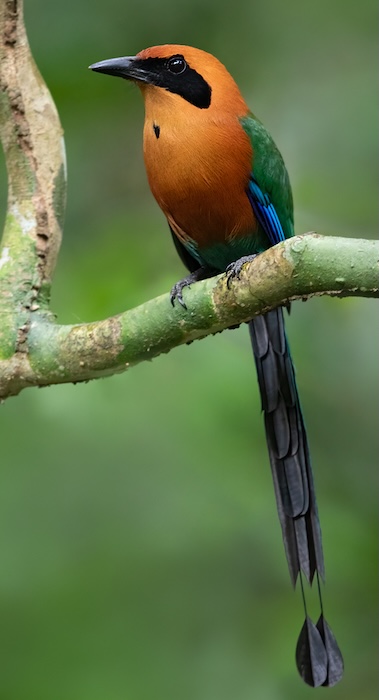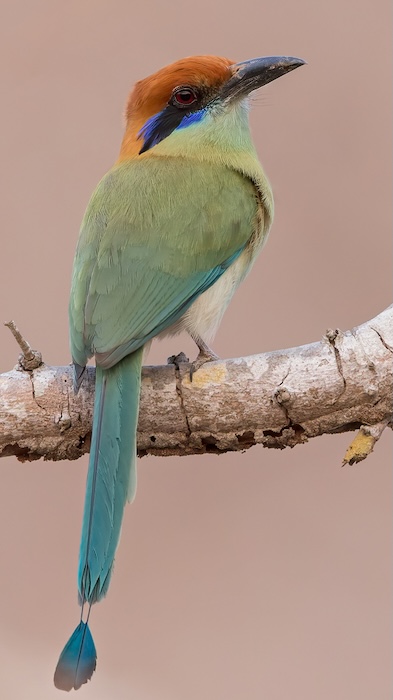Momotidae – Motmots
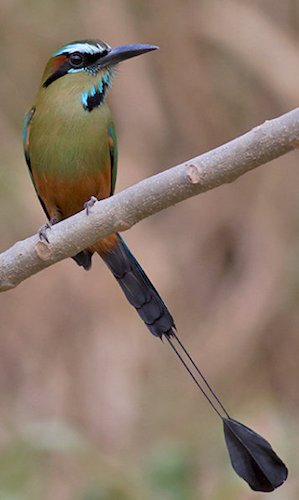
The Momotidae or Motmots are a family of birds in the near passerine order Coraciiformes, which also includes Todidae (Todies), Brachypteraciidae (Ground-Rollers), Coraciidae (Rollers), Meropidae (Bee-eaters) and Alcedinidae (Kingfishers). All extant motmots are restricted to woodland or forest in the Neotropics, and the largest diversity is in Middle America. They have a colourful plumage and a relatively heavy bill. All except the Tody Motmot have relatively long tails that in some species have a distinctive racket-like tip.

Tody Motmot Hylomanes momotula
All Photos in this text ©Dubi Shapiro
They eat small prey such as insects and lizards, and will also take fruit. In Costa Rica, motmots have been observed feeding on poison dart frogs.
|
|
|
|
Andean Motmot Momotus aequatorialis |
Rufous Motmot Baryphthengus martii |
Like most of the Coraciiformes, motmots nest in tunnels in banks, laying about four white eggs. Similarly to Bee-eaters, some species form large colonies of up to 40 paired individuals. The eggs hatch after about 20 days, and the young leave the nest after another 30 days. Both parents care for the young.
|
|
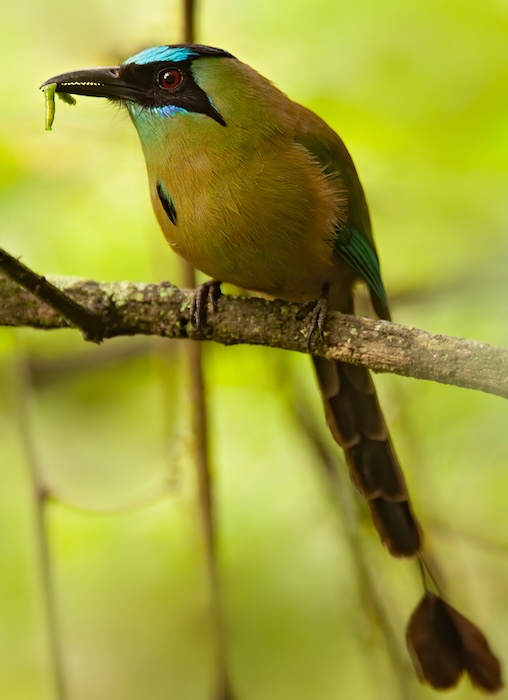 |
| Russet-crowned Motmot Momotus mexicanus |
Whooping Motmot Momotus subrufescens |
Motmots often move their tail back and forth in a wag-display that commonly draws attention to an otherwise hidden bird. Research indicates that motmots perform the wag-display when they detect predators (based on studies on Turquoise-browed Motmot) and that the display is likely to communicate that the motmot is aware of the predator and is prepared to escape. This form of interspecific pursuit-deterrent signal provides a benefit to both the motmot and the predator: the display prevents the motmot from wasting time and energy fleeing, and the predator avoids a costly pursuit that is unlikely to result in capture. There is also evidence that the male tail, which is slightly larger than the female tail, functions as a sexual signal in the Turquoise-browed Motmot.
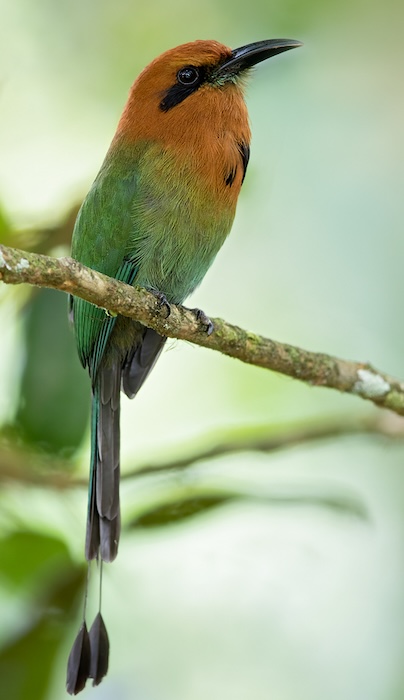 |
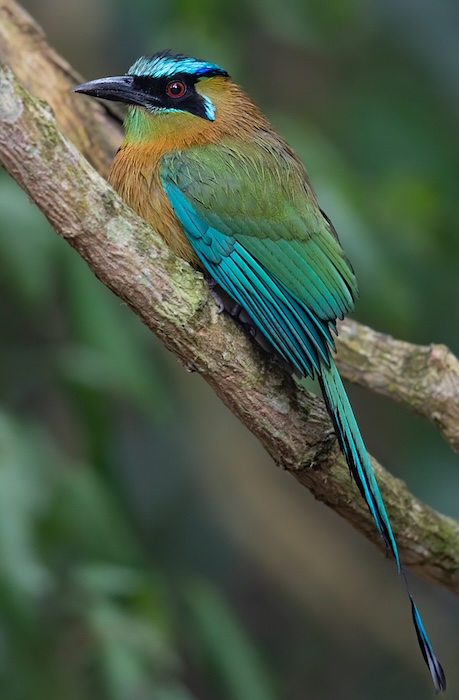 |
| Broad-billed Motmot Electron platyrhynchum | Lesson’s Motmot Momotus lessonii |
In several species of motmots, the barbs near the ends of the two longest (central) tail feathers are weak and fall off due to abrasion with substrates, or fall off during preening, leaving a length of bare shaft, thus creating the racket shape of the tail. It was however, wrongly believed in the past that the motmot shaped its tail by plucking part of the feather web to leave the racket. This was based on inaccurate reports. It has since been shown that these barbs are weakly attached and fall off during routine preening. There are however also several species where the tail is ‘normal’, these being the Tody Motmot, Blue-throated Motmot, Rufous-capped Motmot, and the Amazonian populations of the Rufous and Broad-billed Motmots.
-
Number of bird species: 14
(As at August 2025)
According to the recently (2025) combined AviList, there are fourteen extant species of Motmots in six genera in the Motmotidae family. They are:
Tody Motmot Hylomanes momotula
Turquoise-browed Motmot Eumomota superciliosa
Keel-billed Motmot Electron carinatum
Broad-billed Motmot Electron platyrhynchum
Blue-throated Motmot Aspatha gularis
Rufous-capped Motmot Baryphthengus ruficapillus
Rufous Motmot Baryphthengus martii
Russet-crowned Motmot Momotus mexicanus
Blue-capped Motmot Momotus coeruliceps
Lesson’s Motmot Momotus lessonii
Whooping Motmot Momotus subrufescens
Trinidad Motmot Momotus bahamensis
Amazonian Motmot Momotus momota
Andean Motmot Momotus aequatorialis
-
Motmotidae
Family AccountOligocene fossils bearing on the origins of the Todidae and Motmotidae (Aves: Coraciiformes). -
Motmotidae
Family AccountThe motmots or Momotidae are a family of birds in the order coraciiformes, which also includes the kingfishers, bee-eaters and rollers.
Given that this is a relatively small family with just fourteen species in only six genera, Fatbirder provides active links below to all species.
-
Amazonian Motmot Momotus momota
Species AccountMedium-sized motmot. Green with orange underparts, black mask, and blue crown. Other motmots in its range have orange heads... -
Amazonian Motmot Momotus momota
Species AccountThe Amazonian motmot (Momotus momota) is a colourful near-passerine bird found in the Amazonian forests from eastern Venezuela to northeastern Argentina. This species and the blue-capped motmot, whooping motmot, Trinidad motmot, Lesson's motmot, and Andean motmot were all considered conspecific. -
Amazonian Motmot Momotus momota
Species AccountMomotus momota is listed as Least Concern. -
Amazonian Motmot Momotus momota
Species AccountSound archive and distribution map. -
Andean Motmot Momotus aequatorialis
Species AccountSpecies AccountThe Andean motmot or highland motmot (Momotus aequatorialis) is a colorful near-passerine bird found from northern Colombia to western Bolivia. -
Andean Motmot Momotus aequatorialis
Species AccountSound archive and distribution map. -
Blue-capped Motmot Momotus coeruliceps
Species AccountLarge motmot of humid forest and edge in tropical lowlands and foothills of northeast Mexico. -
Blue-capped Motmot Momotus coeruliceps
Species AccountSound archive and distribution map. -
Blue-throated Motmot Aspatha gularis
Species AccountScarce inhabitant of highland forests in Chiapas and south to Honduras. -
Blue-throated Motmot Aspatha gularis
Species AccountSound archive and distribution map. -
Broad-billed Motmot Electron platyrhynchum
Species AccountThis species has an extremely large range, and hence does not approach the thresholds for Vulnerable under the range size criterion (Extent of Occurrence <20,000 km2 combined with a declining or fluctuating range size, habitat extent/quality, or population size and a small number of locations or severe fragmentation). -
Broad-billed Motmot Electron platyrhynchum
Species AccountMedium-sized forest dweller that sits motionless on horizontal branches in the mid-story. Head and breast rufous-orange with black mask and breast spot. -
Broad-billed Motmot Electron platyrhynchum
Species AccountThe broad-billed motmot (Electron platyrhynchum) is a species of bird in the Momotidae family. -
Broad-billed Motmot Electron platyrhynchum
Species AccountSound archive and distribution map. -
Keel-billed Motmot Electron carinatum
Species AccountThe keel-billed motmot (Electron carinatum) is a Vulnerable species of bird in the motmot family Momotidae. -
Keel-billed Motmot Electron carinatum
Species AccountSound archive and distribution map. -
Lesson’s Motmot Momotus lessonii
Species AccountSound archive and distribution map. -
Lesson’s Motmot Momotus lessonii
Species AccountLesson's motmot (Momotus lessonii) or the blue-diademed motmot, is a colorful near-passerine bird found in forests and woodlands of southern Mexico to... -
Rufous Motmot Baryphthengus martii
Species AccountLarge forest-dweller that likes to sit motionless. Head and breast rufous-orange with black mask and breast spot. Green back and long tail. -
Rufous Motmot Baryphthengus martii
Species AccountThe rufous motmot (Baryphthengus martii) is a near-passerine bird which is a resident breeder in rain forests from northeastern Honduras south to western Ecuador, northeastern Bolivia, and southwestern Brazil. -
Rufous Motmot Baryphthengus martii
Species AccountSound archive and distribution map. -
Rufous-capped Motmot Baryphthengus ruficapillus
Species AccountLarge odd-looking bird with a long tail often swung from side to side or even held cocked when agitated. -
Rufous-capped Motmot Baryphthengus ruficapillus
Species AccountThe rufous-capped motmot (Baryphthengus ruficapillus) is a species of bird in the Momotidae family. It is found in Argentina, Brazil, and Paraguay. -
Rufous-capped Motmot Baryphthengus ruficapillus
Species AccountSound archive and distribution map. -
Russet-crowned Motmot Momotus mexicanus
Species AccountFairly common but easily overlooked inhabitant of tropical lowlands and foothills in... -
Russet-crowned Motmot Momotus mexicanus
Species AccountSound archive and distribution map. -
Tody Motmot Hylomanes momotula
Species AccountSmall and infrequently seen bird of shady forest understory in humid tropical lowlands. Rather inactive. -
Tody Motmot Hylomanes momotula
Species AccountSound archive and distribution map. -
Trinidad Motmot Momotus bahamensis
Species AccountFantastic bird with a long, racket-tipped tail found only in Trinidad and Tobago, where it is the only motmot. -
Trinidad Motmot Momotus bahamensis
Species AccountSound archive and distribution map. -
Turquoise-browed Motmot Eumomota superciliosa
Species AccountSpectacular motmot of tropical lowlands, mainly in drier areas. Favors dry forest and edge, semiopen areas with scattered trees, gardens. -
Turquoise-browed Motmot Eumomota superciliosa
Species AccountThe turquoise-browed motmot (Eumomota superciliosa) is a colourful, medium-sized bird of the motmot family, Momotidae. It inhabits Central America from south-east Mexico (mostly the Yucatán Peninsula), to Costa Rica, where it is common and not considered threatened. -
Turquoise-browed Motmot Eumomota superciliosa
Species AccountSound archive and distribution map. -
Whooping Motmot Momotus subrufescens
Species AccountLarge motmot of lowland forest and edges from eastern Panama to northwestern South America. -
Whooping Motmot Momotus subrufescens
Species AccountSound archive and distribution map.


